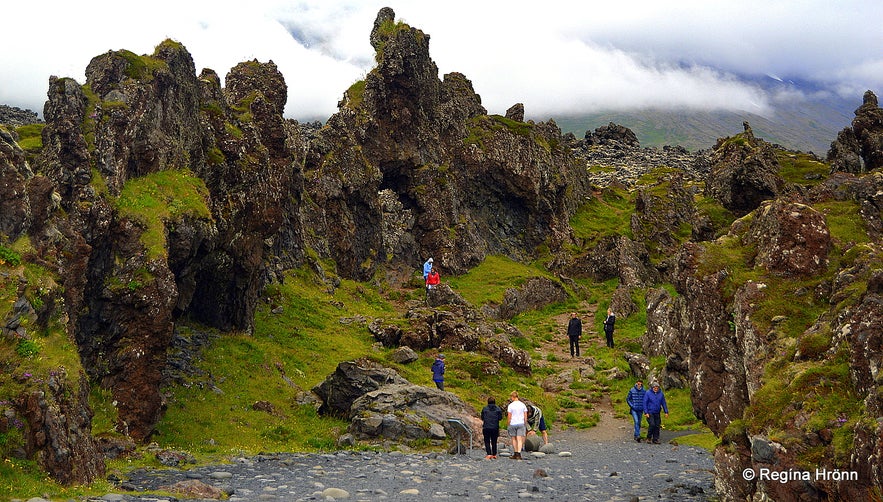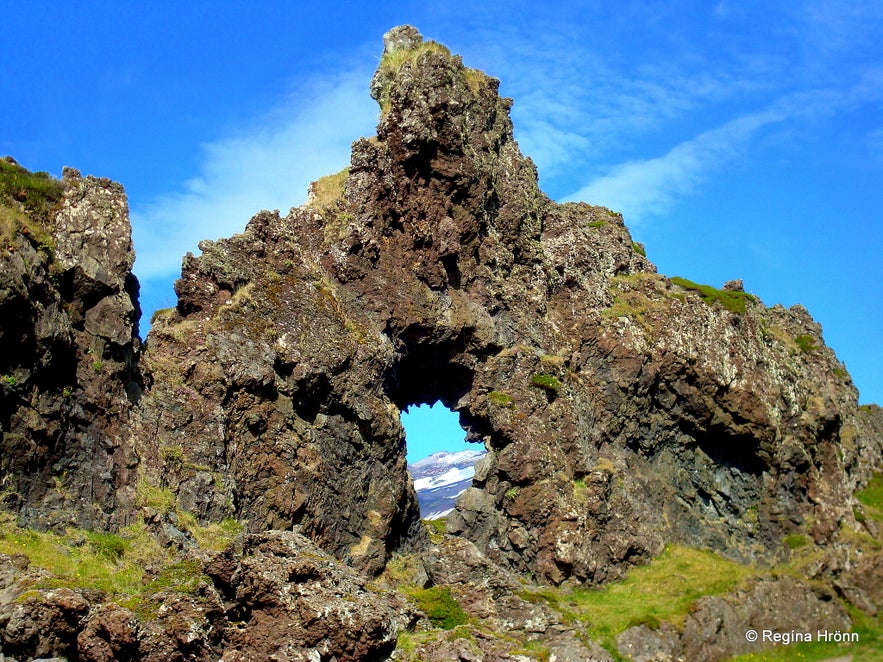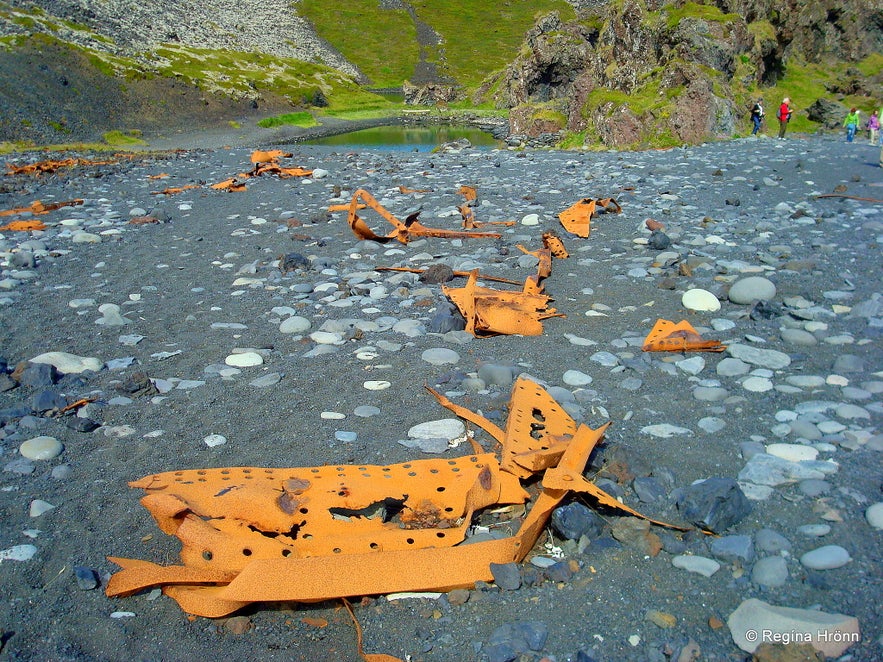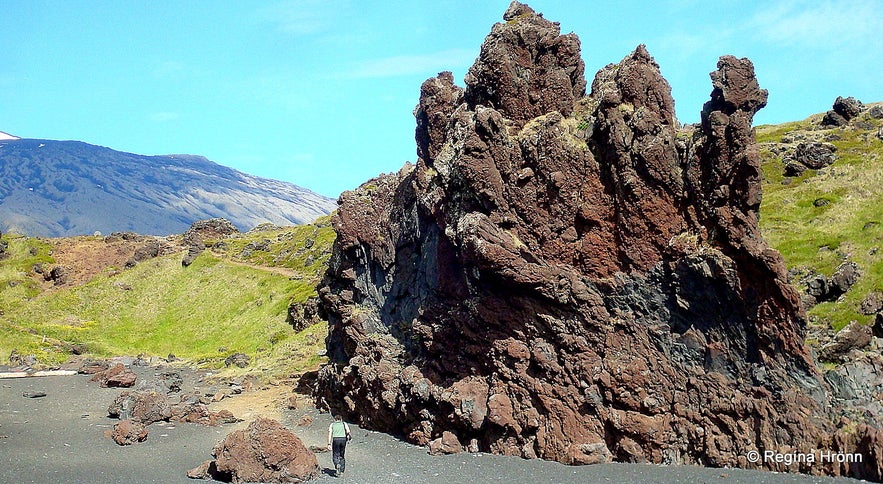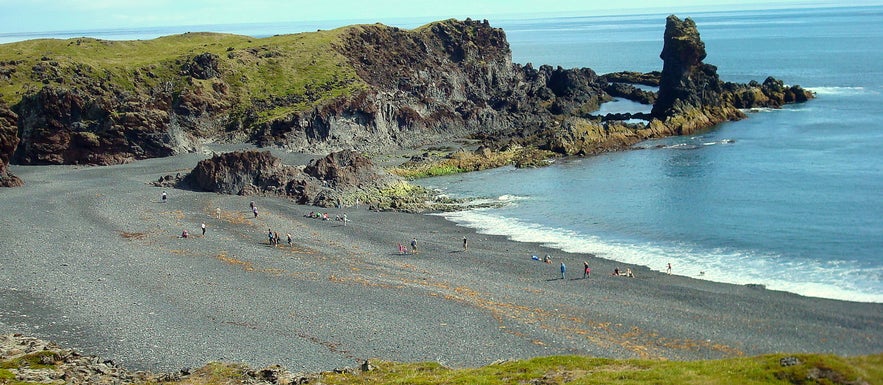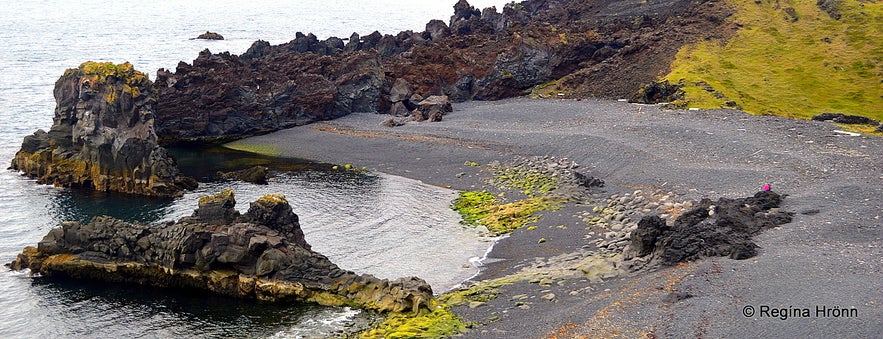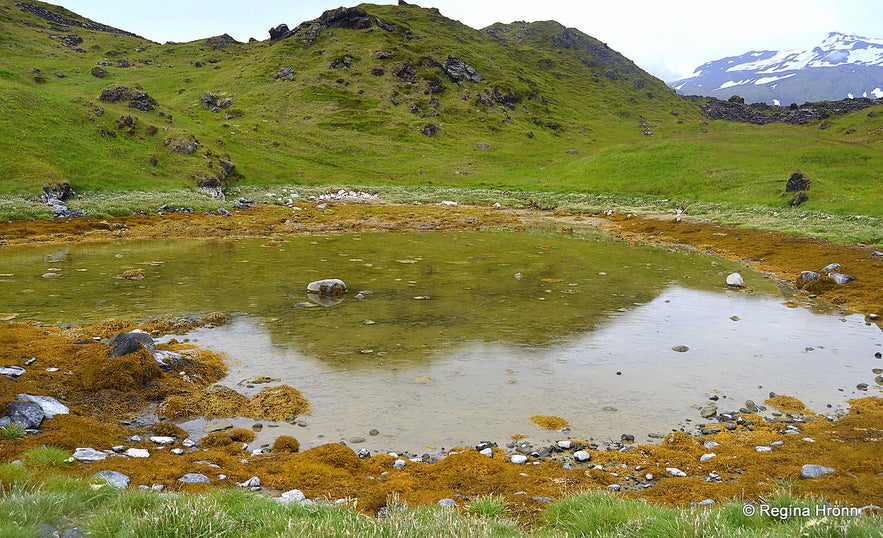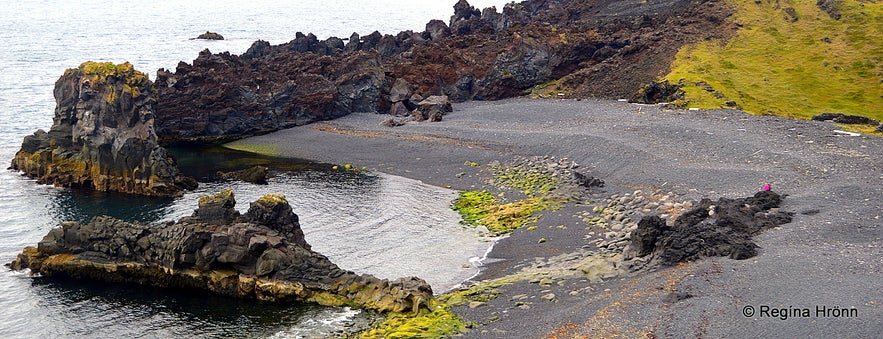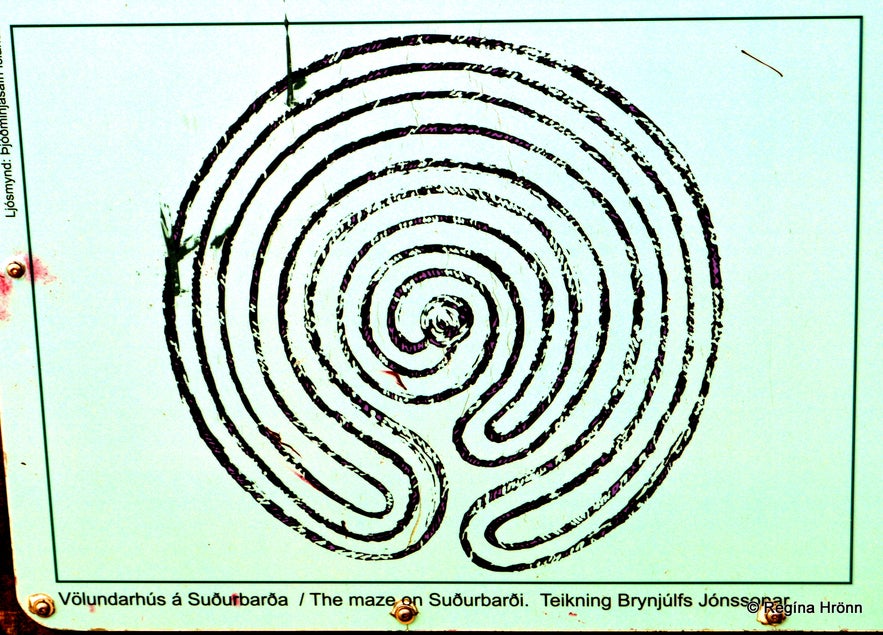Djúpalónssandur - the Black Lava Pearl Beach is a beautiful place to visit, like so many other sights on the Snæfellsnes peninsula.
It is like stepping into a lava wonderland.
I have written a travel guide in chronological order, in 5 parts, about the Snæfellsnes peninsula.
Since Djúpalónssandur is one of the peninsula's major attractions, I think it deserves a special travel blog where I tell you more about its history and folklore connected to this popular beach.
Top photo: people entering Djúpalónssandur via Nautastígur path
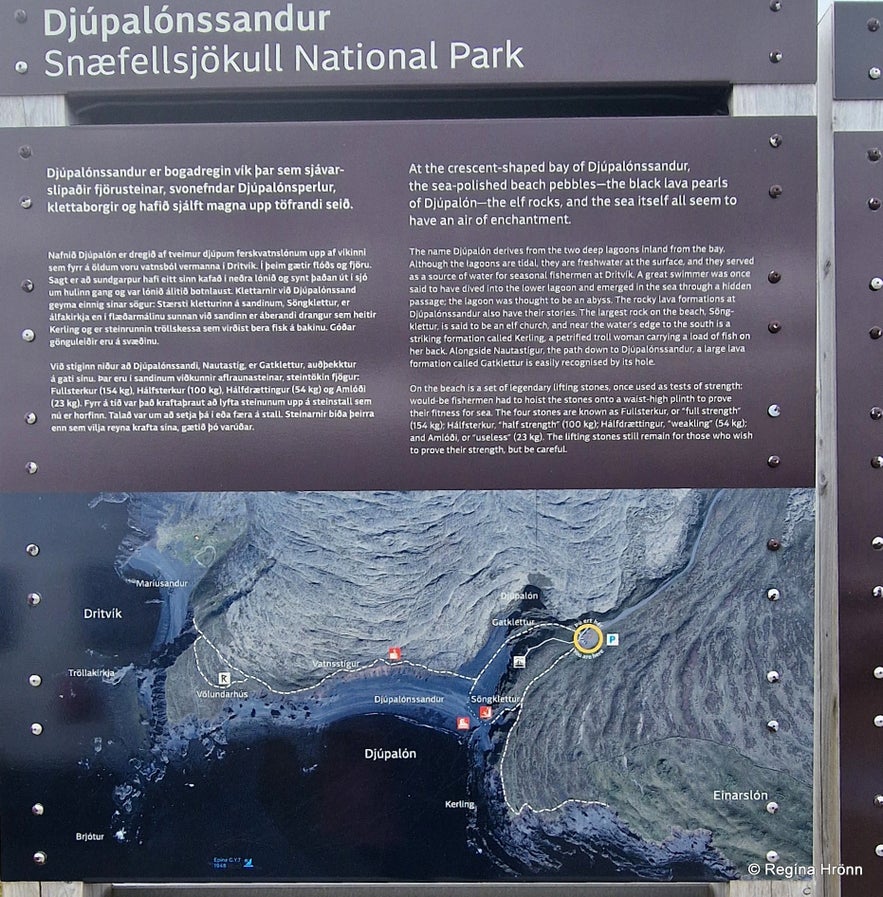 The information sign in the parking lot
The information sign in the parking lot
Here on the Djúpalónssandur and Dritvík beaches, you will find both trolls and elves, and ghosts!
I will tell you the story about the woman who was used as bait and got her revenge in the end. Also, the story about the ghosts in the cave by Dritvík, and the music and singing coming from the elf church on the beach.
Maybe I should start by telling you what the name Dritvík means? Can you believe that it is called Excrement Cove!
When the settlers arrived in the cove on their ship, they relieved themselves. Only to find that all the sh... greeted them when they came ashore ;)
Gatklettur rock
First, let's visit Djúpalónssandur beach.
A short drive on a gravel road takes you down to Djúpalónssandur, and you can leave your car in the parking lot just above Djúpalónssandur.
You reach the beach by descending the Nautastígur path - the Path of the Bull.
The path will take you through a lava field with huge lava formations. To me, this is the most beautiful part of Djúpalónssandur. 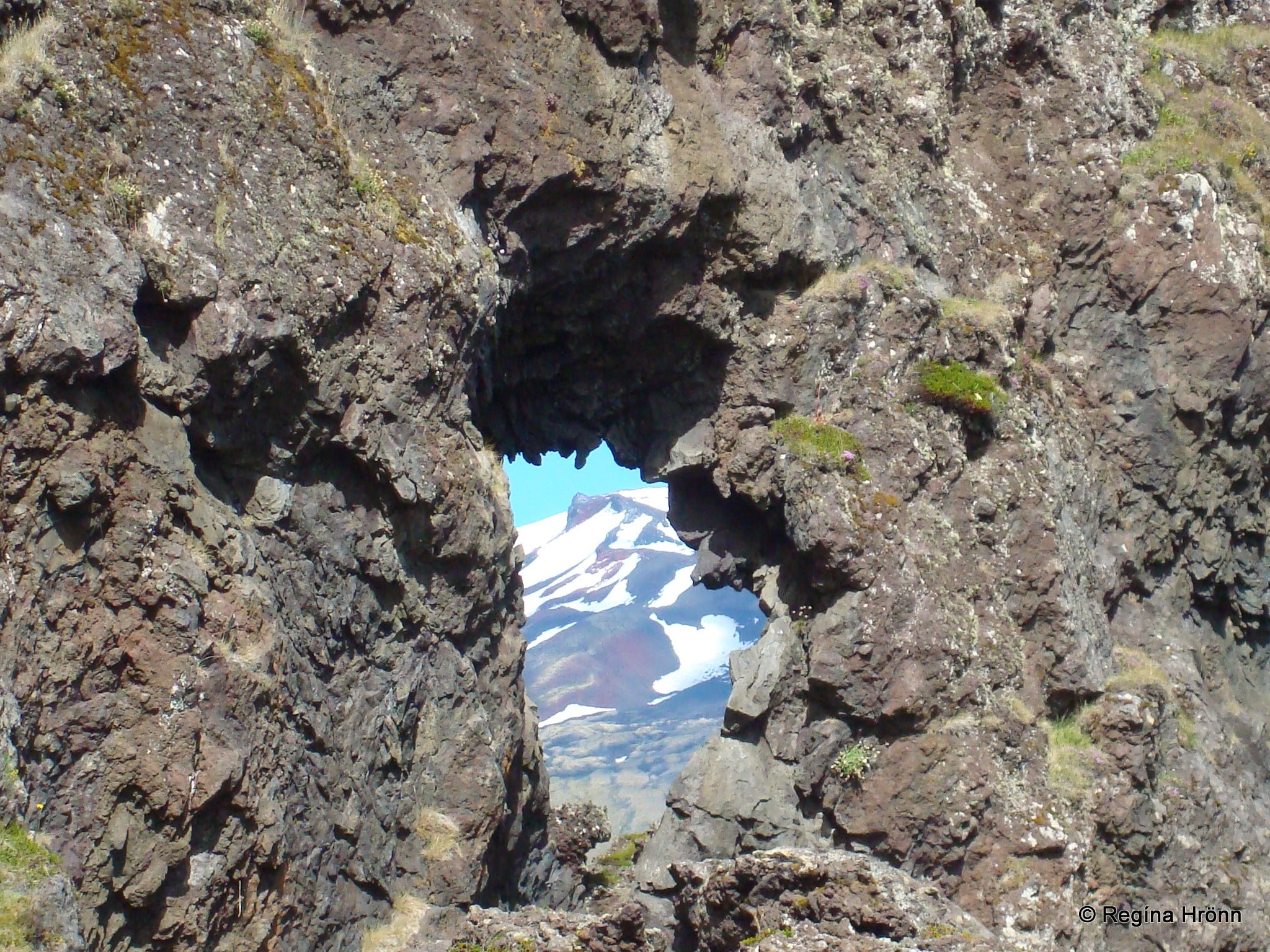
Photo of the rock and Snæfellsjökull on a rainy day
There is a peculiar rock here with a hole in it, called Gatklettur. Through the hole, you can see the Snæfellsjökull glacier.
This is a good photo spot, especially on a fine sunny day, like the day I got on one of my many visits to the Snæfellsnes peninsula.
I have visited Djúpalónssandur beach in almost all types of weather, mainly dark and stormy weather, but my favourite photos are from a sunny day back in 2010, so I also include them here in my travel blog.
The name of the path, Nautastígur - the Path of the Bulls, derives from bulls being led down this path and watered by the lagoon.
There are two small freshwater lagoons behind Nautastígur, called Djúpulón - the Deep Lagoons, but this beach got its name from these lagoons; Djúpalónssandur - the Deep Lagoon's Sand or Beach.
Djúpulón lagoon was said to be abysmal as it was so deep. It was measured by the noted Eggert Ólafsson (1726-1768) and turned out to be about 5 meters deep, not abysmal.
The other lagoon is called Svörtulón - the Black Lagoons.
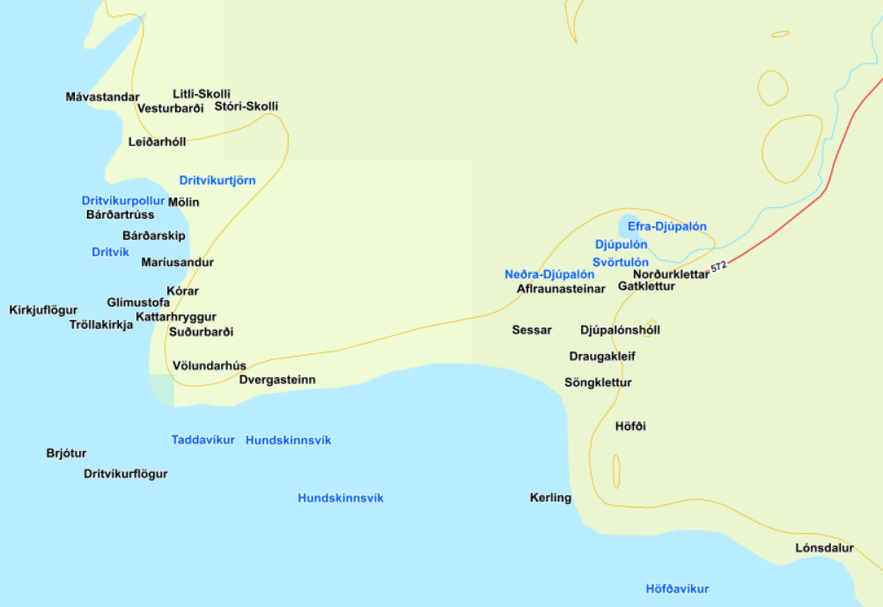
Only the surface water in these two lagoons is freshwater as they rise and fall with the tide.
Svörtulón contains better water, though, as a creek runs into it.
There are four lagoons marked on the map with topographical names: Efra-Djúpalón, Djúpulón, Svartalón, and Neðra-Djúpalón. I only saw 2 of them.
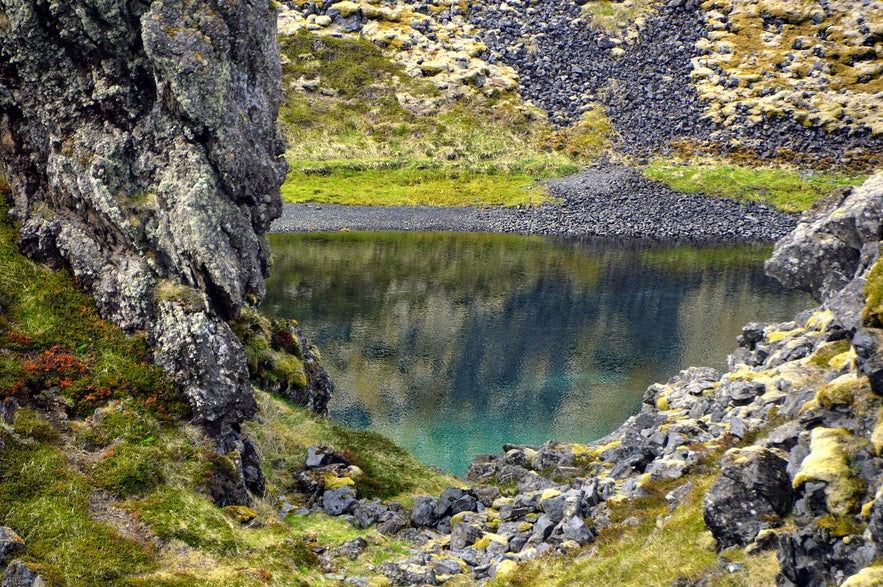 One of the lagoons at Djúpalónssandur
One of the lagoons at Djúpalónssandur
Bishop Guðmundur góði or Guðmundur the Good (1161-1237) is said to have blessed the lagoon in his time, but he blessed many springs, including the Maríulind spring at Hellnar and many others around Iceland.
Some of the springs that this good bishop blessed so many centuries ago are said to have healing properties.
One of the lagoons at Djúpalónssandur beach
We Icelanders still hold these springs in high regard, and it hurt me so much to see one of these springs up north filled with WC paper :(
I have written about some of the springs in this travel blog: Laugarhóll at Strandir - hot pools and sorcery in abundance.
The British trawler the Epine GY7
Iron pieces from the British trawler the Epine GY7
On the beach, you will notice the iron pieces from the British trawler the Epine GY7, which was wrecked east of Dritvík cove on the night of 13th March 1948.
Fourteen men lost their lives, and five of the men were saved by the Icelandic rescue team in the neighbouring villages, which managed, after two long and cold hours, to get a line to the trawler.
There was a blizzard on this cold winter night in March, and the fishermen were losing their grip and had started falling into the cold sea :(
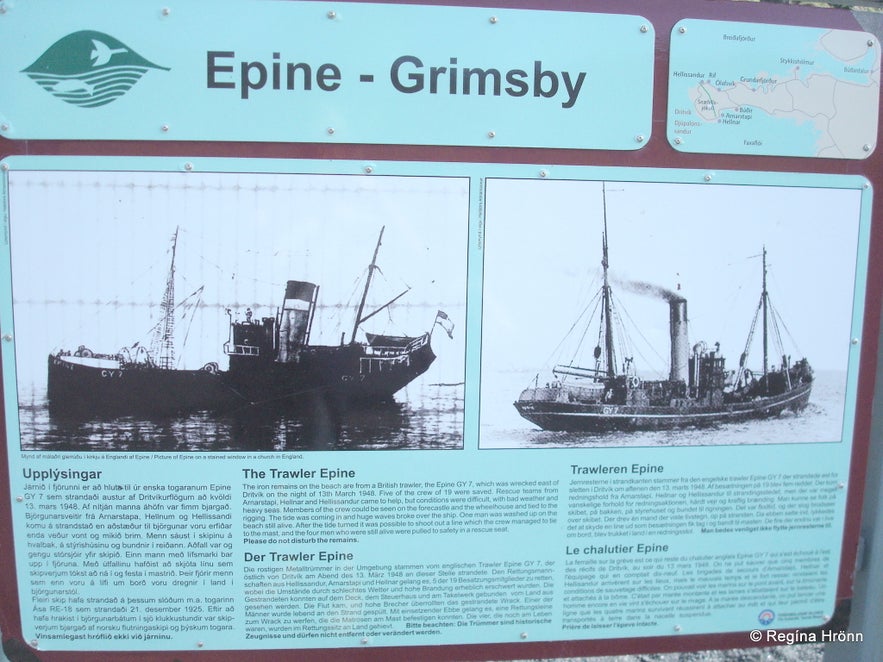 The information sign on Djúpalónssandur beach
The information sign on Djúpalónssandur beach
One of them fell overboard and washed ashore, where the rescue team saved him. Three others were already dead, and their bodies washed up on the beach.
Many of the fishermen were never found.
The skipper, Alfred Loftis, clinging to the ship, shouted to the rescue team: "I do not mind what happens to me as long as the boys are all right. Look after the boys!"
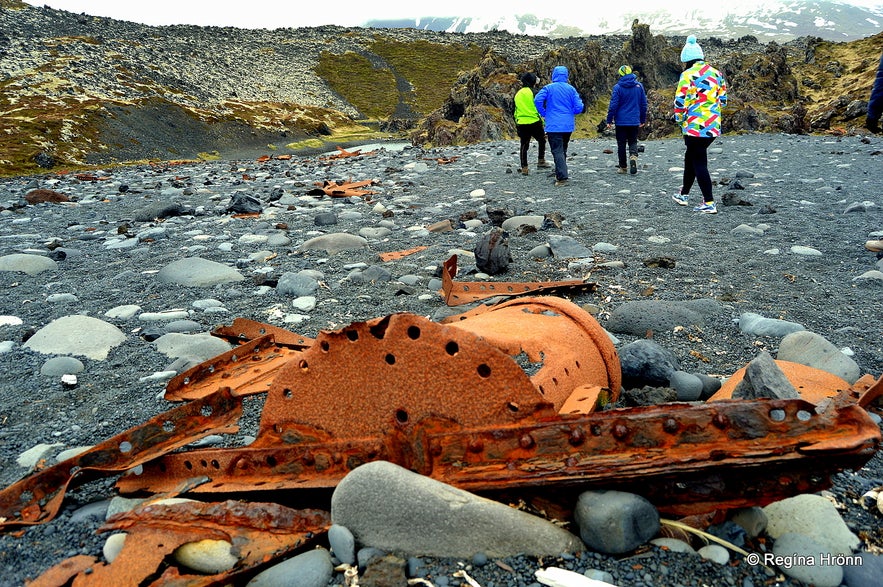
Iron pieces from the British trawler the Epine GY7
Shortly after he was gone, swept away by a big wave :(
It is just heartbreaking thinking about the fate of these English fishermen.
The iron remains that washed up on the beach are protected and should not be tampered with. They are kept here in memory of these brave fishermen from England, so let's respect them and leave them in peace.
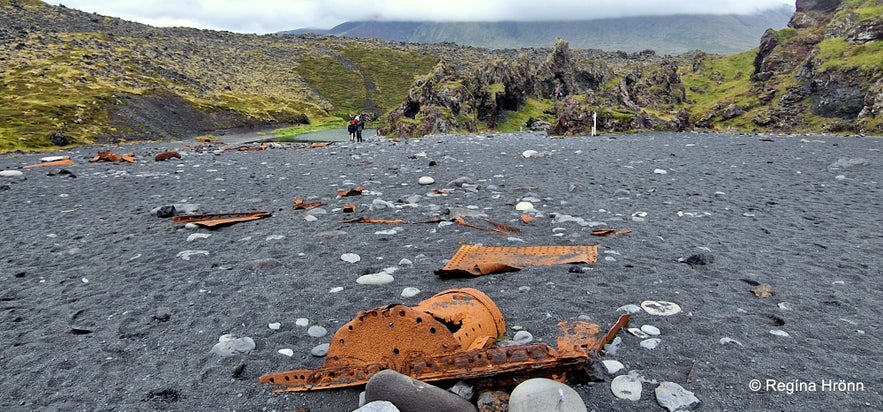 Iron pieces from the British trawler the Epine GY7 in 2025
Iron pieces from the British trawler the Epine GY7 in 2025
There have been other shipwrecks in this area, as in so many places here on the Snæfellsnes peninsula.
Djúpalónsperlur - the Black Pearls of Djúpalón
Djúpalónsperlur - the Pearls of Djúpalón
When you exit the lava field, you will enter the black Lava Pearl Beach, and the whole beach is made of small, smooth black pebbles called Djúpalónsperlur - Pearls of Djúpalón.
The black lava pearls of Djúpalón are protected, but I have seen them used for jewellery.
My pictures don't even begin to do these pebbles justice, as they can be ever so soft and pitch-black, as if polished. Which they of course were, polished by the waves, and each other.
I got a letter from a traveller, who told me that she had taken some of the pebbles back home with her. Since she took them, she had experienced some bad luck and blamed it on the pebbles
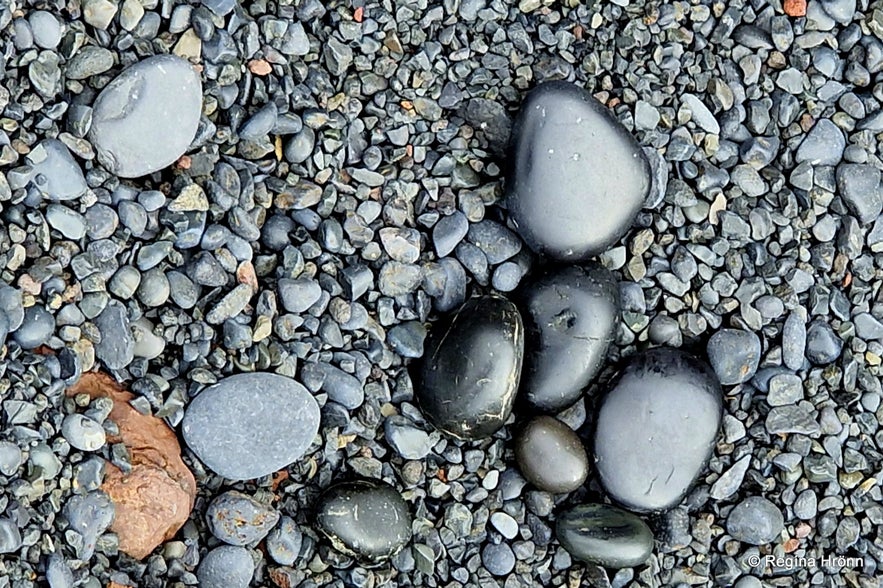 Djúpalónsperlur - Pearls of Djúpalón that were returned to Djúpalónssandur beach
Djúpalónsperlur - Pearls of Djúpalón that were returned to Djúpalónssandur beach
She wanted to return them, and I told her to write to the Snæfellsnes Visitor Centre, ask if she could send the pebbles to them, and ask them to return them to Djúpalónssandur.
So let's leave them in peace, as on Djúpalónssandur beach there are both trolls and elves - the Hidden people of Iceland, so we never know, the pebbles might be enchanted.
Söngklettur - Singing Rock - the Church of the Elves
Söngklettur - the Singing Rock - the Church of the Elves
You will notice a very distinctive huge lava rock on the beach, Söngklettur - the Singing Rock. The rock is reddish and very majestic looking - it is said to be the Church of the Elves!
It looks impressive, and on one occasion, when I went on a guided tour of the Snæfellsnes peninsula, we had a picnic by Söngklettur.
Could you make sure to show respect around elf locations and not climb on them or make a racket? Always ask the elves for permission to visit their habitation or churches, and you will be fine. Respect is the keyword here.
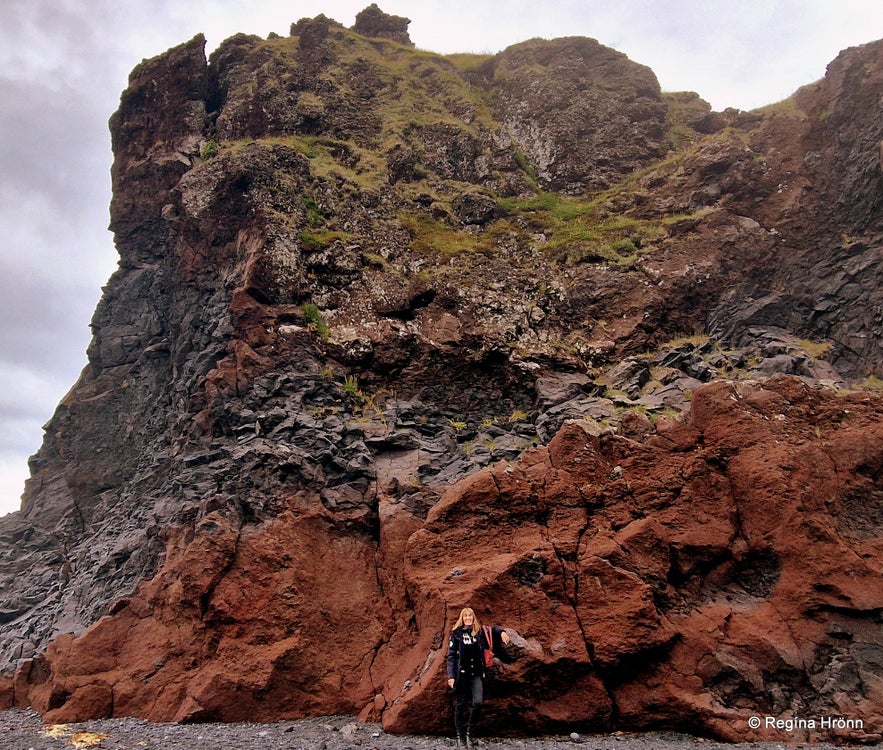
Visiting Söngklettur in the summer of 2025 - I cannot catch a break here - a storm was approaching
Respect for the elves is deep-seated in the soul of the Icelandic nation, and we learn about them in our upbringing, so we always show respect for the elves and fear their wrath if their habitations or churches are disrespected.
See also: Tungustapi in Sælingsdalur - the Church of the Elves in West Iceland.
I always ask them for permission to visit their homes or churches and thank them when I leave. And I whisper during my visit, as they dislike racket.
There are many stories of misfortune if this rule is not followed. See my travel blog: Mt. Pétursey in South Iceland and the Elves - Icelandic Folklore.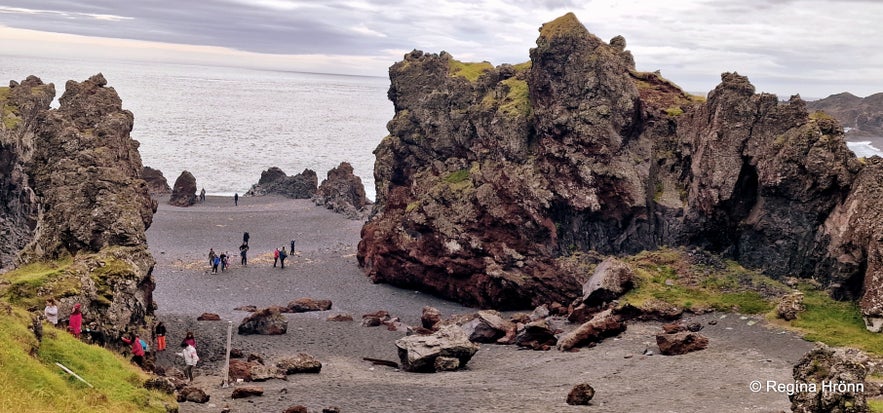
Söngklettur elf church as seen from above - a blue hue makes the colours look weird.
I know that our foreign visitors cannot know where all these different elf locations are to be found, a rock might seem like a rock, which is why I am writing about the elf locations in Iceland in my travel blogs.
I found one story about Söngklettur in the book Hulduheimar - Hidden Worlds by Árni Óla and translated it into English:
"On the beach between Einarslón and Djúpalón on Snæfellsnes is a large and massive rock called Söngklettur. The folk belief is that there is an elf-church in the rock.
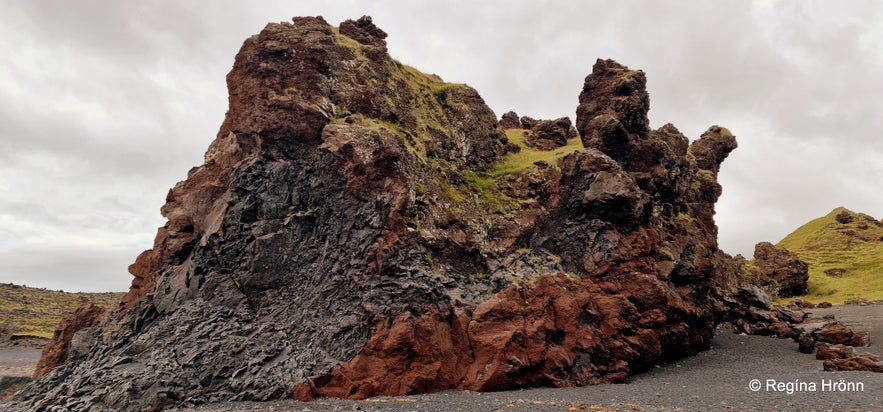 Söngklettur elf church
Söngklettur elf church
One beautiful Sunday in the summer of 1969, I visited Djúpalónssandur, and many people were enjoying the beach's fantastic natural beauty.
I met a man who was born and bred at Einarslón.
I asked him about Söngklettur, and he said: "When I was a teenager, I was sent on New Year's Eve to fetch the sheep from the beach. I then heard loud music and singing coming from this rock.
I heard beautiful organ tones and other musical instruments, which I didn't recognize. The singing was beautiful and multi-voiced psalmody."
(Translated into English from the book Hulduheimar by Árni Óla, pages 87-88)
The man from Einarsón listened to the singing for a long while and then went back home. He asked his grandfather who these people might be. His grandfather answered that they were good people - "huldufólk" - the Hidden People of Iceland.
Many years later, the same man heard violin music from Söngklettur and recognized it as one of the instruments he had heard as a teenager.
There are many, many such stories in Icelandic folklore, but there are also more recent accounts.
The Troll Kerling
Kerling - troll woman
There are more strangely formed lava rocks on Djúpalónssandur, like the one in my photo above. It is called Kerling or the Troll woman, and where there is a Kerling, there is a Karl or the male Troll.
These trolls were turned into stone when they saw daylight, as this is what happens to night trolls in Iceland; they get petrified when they see daylight.
Kerling is carrying a bundle of fish on her back, but I read that Karl is located a bit further east and cannot be seen from Djúpalónssandur.
I walked up on Höfði cape towards Einarslón, further east by the shoreline, to look for him, but there were so many rock formations there that I didn't know which one of them was Karl.
But I have "heard" that Lóndrangur had a thing for Kerling at Djúpalónssandur ;)
Kerling - troll
You will find Karl and Kerling troll formations all over Iceland.
They are not always together, though, as at Lóndrangar cliffs close by, the male troll, Lóndrangur, is by the sea, while his fiancée troll, Kerling, is stuck in Kerlingarskarð pass carrying a bundle of trouts on her back.
You can read about their love story in my travel blog:
Kerlingarskarð Pass in Snæfellsnes in West Iceland - the Folklore of the Giantess & her Fiancé
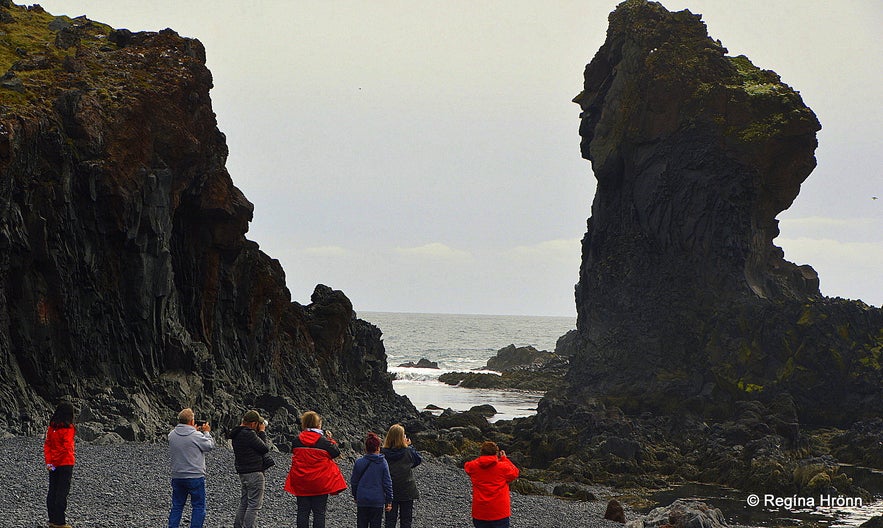
With friends at Djúpalónssandur
I found a dreadful account in Þjóðsögur Jóns Árnasonar - the Compilation of Folklore of Jón Árnason. This is a continuation of the account about the hardy fishermen in my next chapter on the lifting stones:
"The hardy fishermen on Djúpalónssandur beach grabbed an old woman and killed her (others say that they took her body from the barrow, and others say that they dug her from her fresh grave).
The fishermen used the body of this old woman for bait one spring, and they fished so much that their boat was laden every day, even though the other fishermen would hardly catch any fish.

Visiting Djúpalónssandur with friends
All of them used this human flesh for bait, apart from Hálfdrættingur (a man who could lift 54 kilos, see my chapter on the lifting stones below - RHR), who was fishing with them, a man called Sigurður.
One night he dreamt that the old woman approached him and uttered these words: "Verður á morgun skip skarða, Skeður furðu tilburður; Farðu ei á morgun forvarða, furða ber til, Sigurður".
Others have told this story and added to it that the woman also uttered: "Ei skaltu í dag róa; nú ætla ég rugla undir beinum mínum".
The next morning, Sigurður pretended to be ill, but the other fishermen went fishing, and all of them drowned on this day, but it is not mentioned how it came about".
(Translated into English from Þjóðsögur Jóns Árnasonar - the Compilation of Folklore of Jón Árnason).
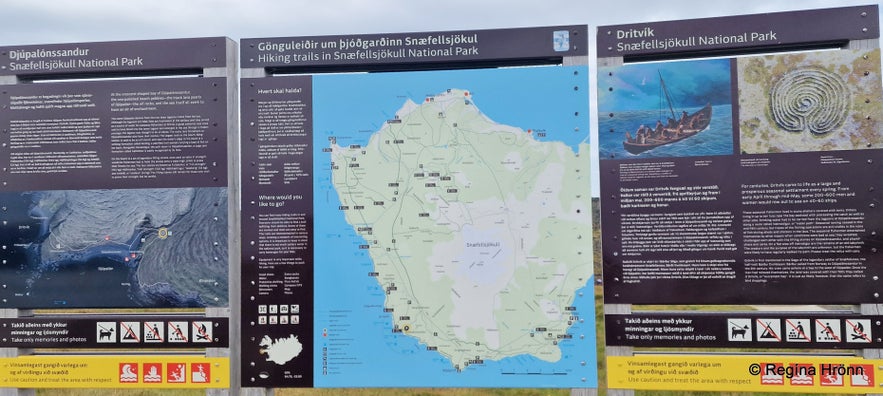 Some folklore is mentioned on the information signs at Djúpalónssandur beach.
Some folklore is mentioned on the information signs at Djúpalónssandur beach.
I am not going to translate what the old woman said, but it is in the form of rhyme, where she warns Sigurður of sailing with the other fishermen the following day, as she was going to get her revenge on the fishermen for using her body as bait!
Dangerous sneaker waves at Djúpalónssandur
Djúpalónssandur beach
The suction of the sea in Djúpalónssandur is very powerful, so please don't go too close to the sea.
There was a warning sign by the parking lot, but I have seen many people ignore it.
Do not wade into the sea - it is better to be safe than sorry.
In the photo above, which I took from the start of the hike to Dritvík cove, people are playing on the shore very close to the sea, but the sea is not always this calm, and often big waves come crashing onto the beach, and they can grab people and carry them out to sea.
Or the dangerous sneaker waves that sneak in, get everybody wet, and can carry people out to sea. So let's be extra careful here!
In 2015, a tour guide dragged people out of the sea.
In 2017, a Slovakian tourist decided to throw himself into the waves completely naked.
Not the best location to practice sea swimming in Iceland, so he quickly returned/was washed ashore, and hopefully, he realized that he was playing with death here. He was lucky to come out of the sea alive.
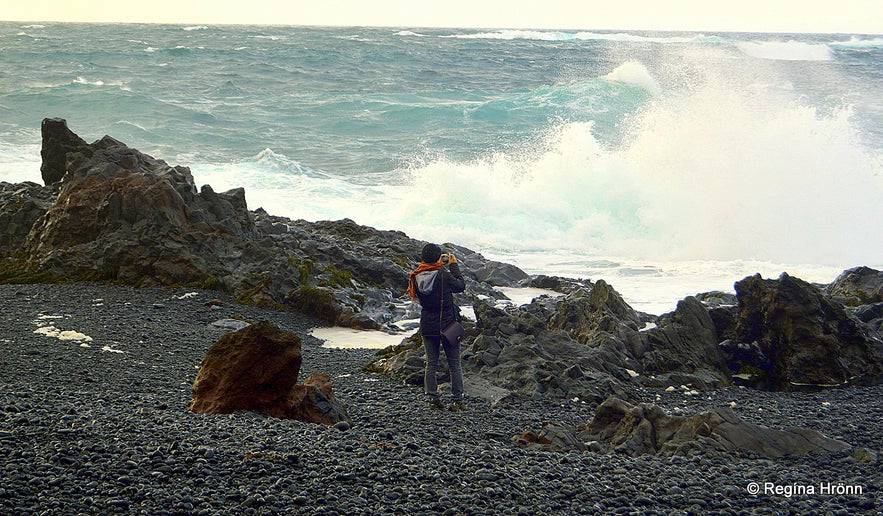
Big waves by Djúpalónssandur
In March 2017, tourists put themselves in danger while "playing" and running after the waves.
A big wave caught them, and fortunately, they were carried towards a sand reef rather than being sucked out to sea.
Three or four big waves usually come in a row, and the last waves come much further onto the shore than the first ones.
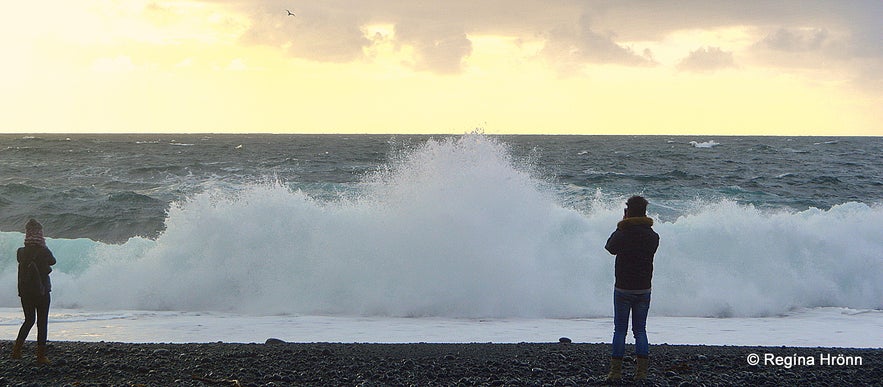
A winter visit to Djúpalónssandur in limited daylight
They surprise people and can carry them out to sea, so never run after waves in this location, as bigger ones will usually follow.
The photo above is from one of my winter trips to Djúpalónssandur. In the dead of winter, daylight is scarce, which is why my photo is so dark, even though it was taken in the middle of the day.
The people in the photo are two employees at Guide to Iceland, so they made sure not to get too close to the sea while they were taking pictures of the waves crashing on the shore.
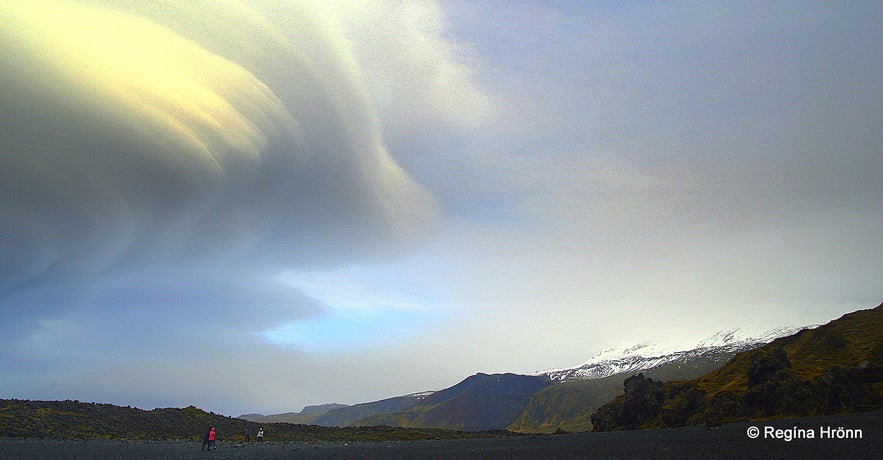
During one of my visits to Djúpalónssandur, a vortex-like cloud was heading for the glacier.
There is another equally dangerous beach in South Iceland, the ever-so-popular Reynisfjara beach.
If you visit it, bear in mind that there have been several fatalities there when unexpected sneaker waves have carried people out to sea, where they have drowned :(
I have written a travel blog about that beach to warn people about the dangers:
Extremely dangerous Waves by Reynisfjara and Kirkjufjara black Beaches in South Iceland!
The lifting stones at Djúpalónssandur
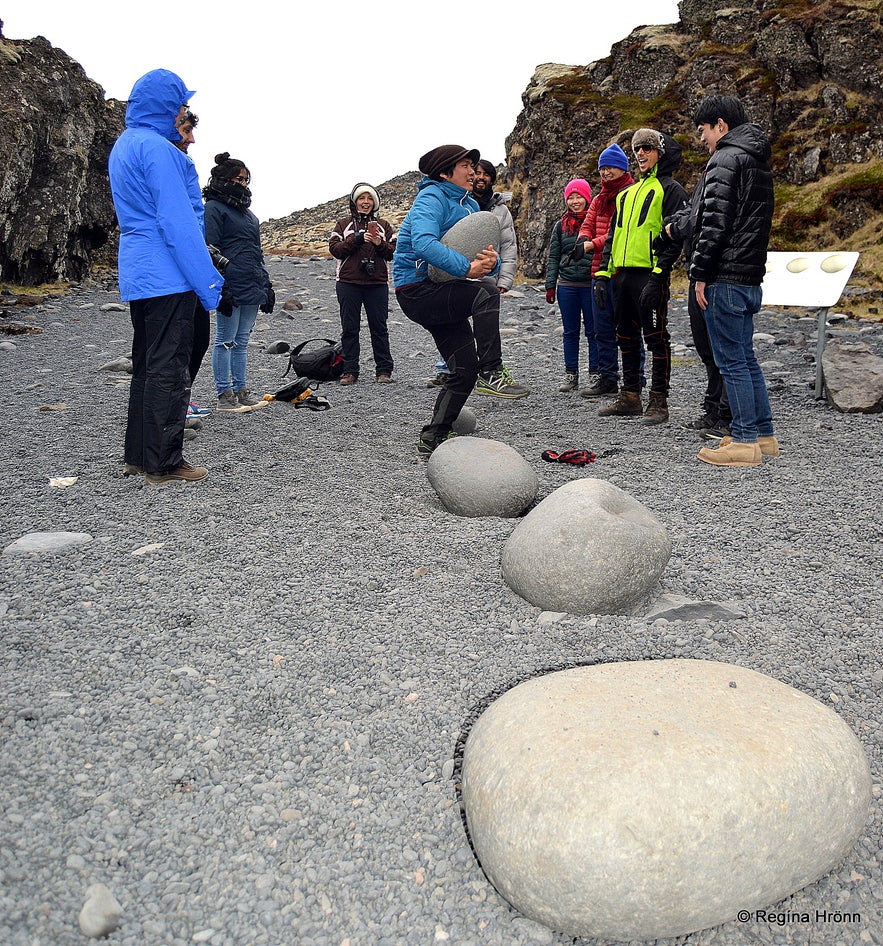
One of the travellers on the day tour with Nicetravel is trying to lift one of the lifting stones
At Djúpalónssandur beach, you will find four differently sized stones. They are well-known Aflraunasteinar - Steinatök or lifting-stones.
They were used to measure the strength of fishermen in Iceland, and you can try your strength on these stones yourself.
This is what Þjóðsögur Jóns Árnasonar - the Compilation of Folklore of Jón Árnason has to say about these lifting stones:
"It has been written that some crew members were fishing from Djúpalónssandur beach, but these men were such strong and energetic fishermen that nothing seemed impossible to them. They tried their strength on these lifting stones.
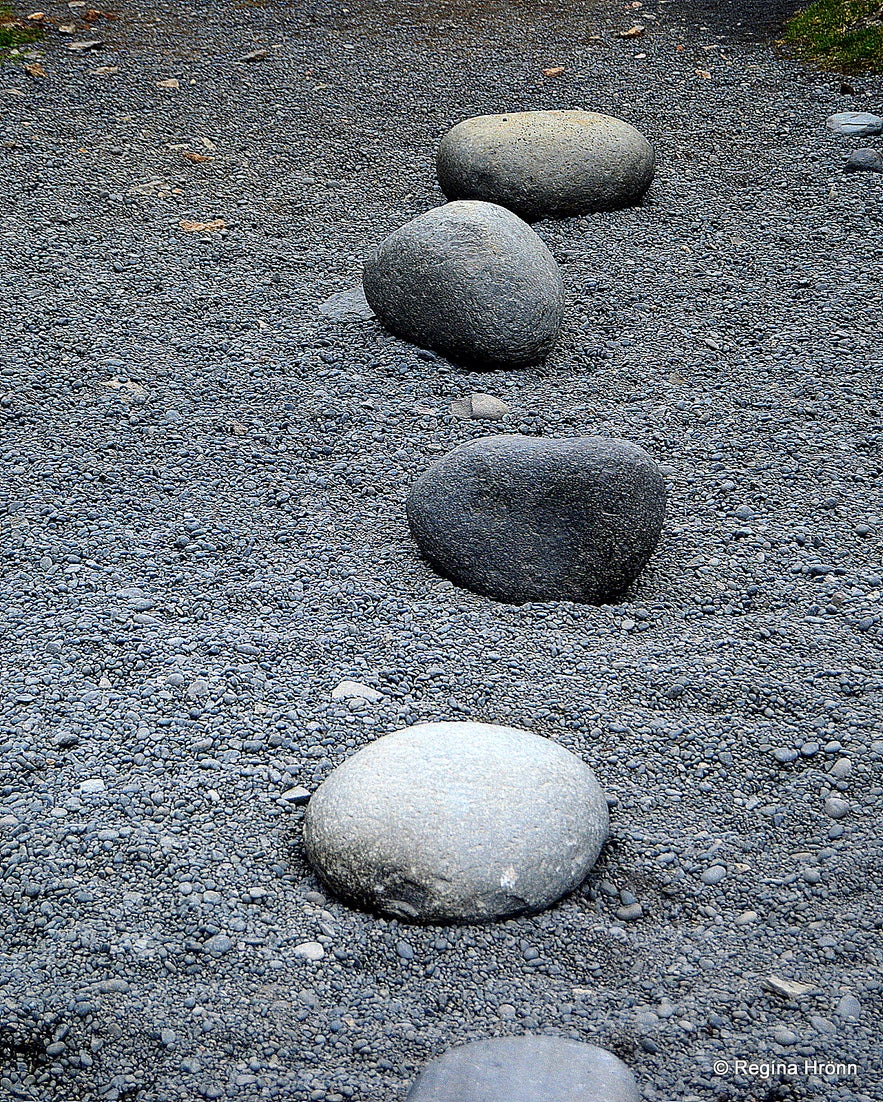
The lifting stones at Djúpalónssandur
The lifting stones are still to be found on Djúpalónssandur beach on the way south to Einarslón lagoon, a little above the road.
The names of the lifting stones are Fullsterkur, Hálfsterkur, and Hálfdrættingur, and only those who could lift Fullsterkur on a plinth reaching a man's waist were allowed to fish from Djúpalónssandur beach.
There still exist some men (a long time ago RHR) fishing from Dritvík, who can lift Fullsterkur, many men can lift Hálfsterkur, but almost all of them can lift Hálfdrættingur".
(Translated into English from Þjóðsögur Jóns Árnasonar - the Compilation of Folklore of Jón Árnason).
The sign by the lifting stones at Djúpalónssandur
The biggest stone is called Strong and weighs 154 kg; only the very strong can lift that one. The second one is called Half-Strong and weighs 100 kg.
The third one is called Half as good and weighs 54 kg, and the fourth one is called Lightweight and weighs 23 kg.
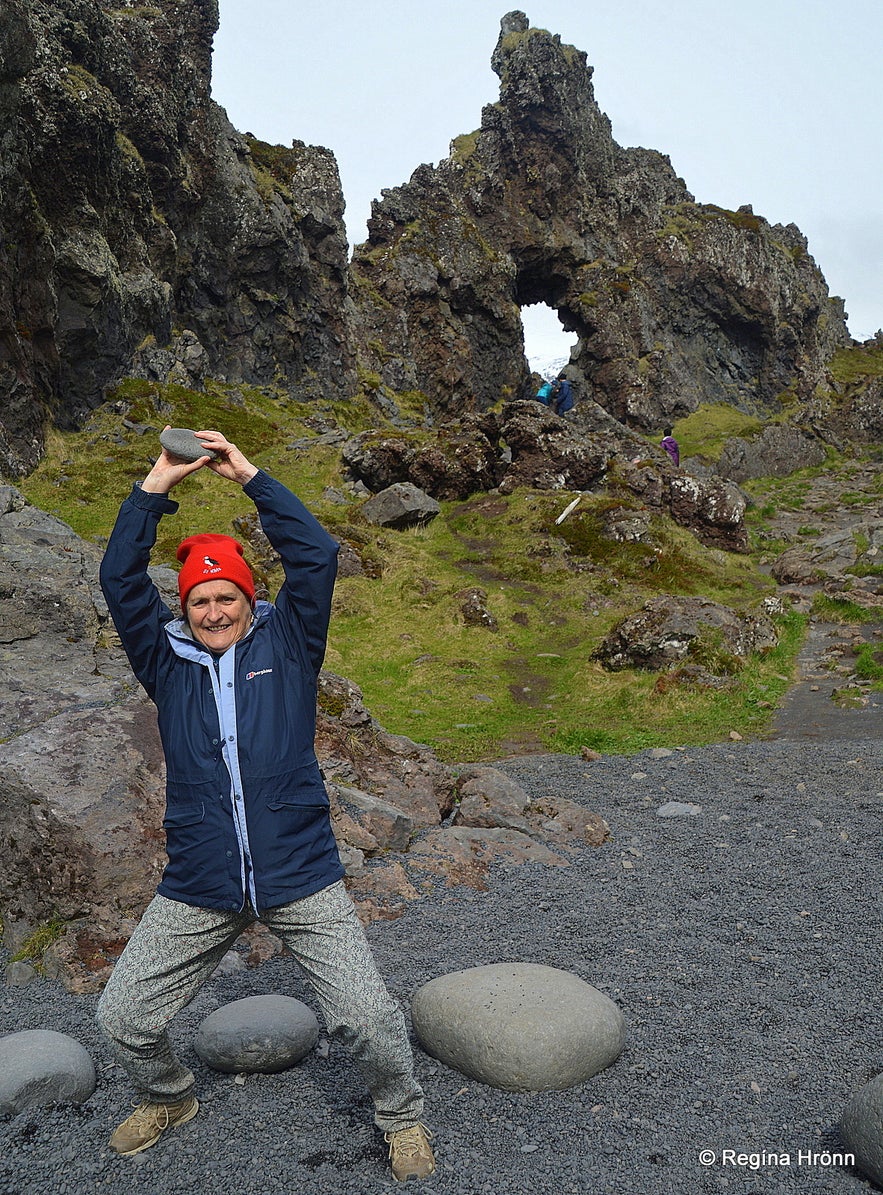 My Irish friend would not be accepted on the fishing boats ;)
My Irish friend would not be accepted on the fishing boats ;)
All these Icelandic names refer to how strong/weak the person is lifting them on a plinth.
If the fishermen could not lift Hálfdrættingur (54 kg), they were not accepted as oarsmen on the fishing boats rowing from Dritvík.
Nowadays, stones like these are used in the strong-man contests, which are very popular here in Iceland.
Dritvík cove
Dritvík cove
You can hike from Djúpalónssandur beach to Dritvík cove, which was the largest seasonal fishing station here in Iceland from the 16th century until the mid-19th century, with 40-60 boats and 200-600 seasonal fishermen.
The season was only in spring from the beginning of April until mid-May.
Both of these former vibrant spots are now deserted, and nowadays they are only visited by tourists and locals alike.
Dritvík has a natural harbour encircled by high lava walls. The black lava beach in this cove is called Maríusandur or the Beach of Mary.
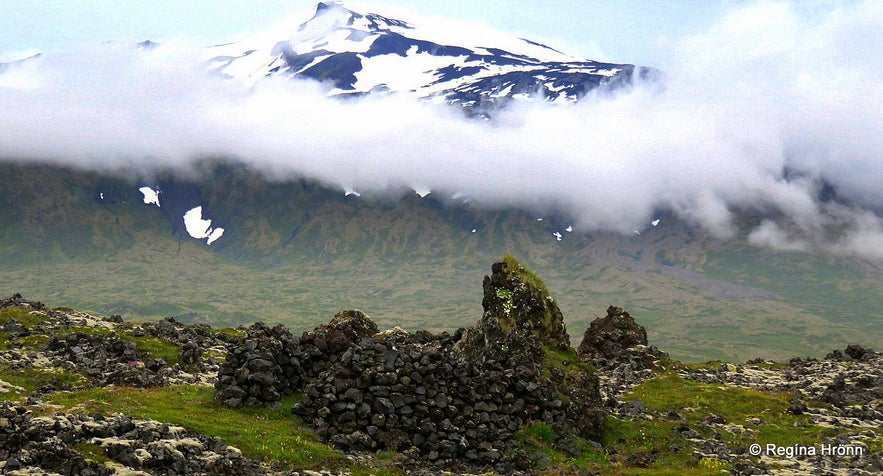
Ruins by Dritvík cove
The hike to Dritvík is only 1 km west of Djúpalónssandur. The path is rocky at the very start of the hike, though, so wear good hiking shoes if you plan on popping over to see Dritvík.
On the west part of the beach and in the lava along the hike, you will see some ruins from that time.
The seasonal fishermen stayed in fishermen's huts built out of rock and sand and covered with tents. There are also ruins of old fish-drying sheds.
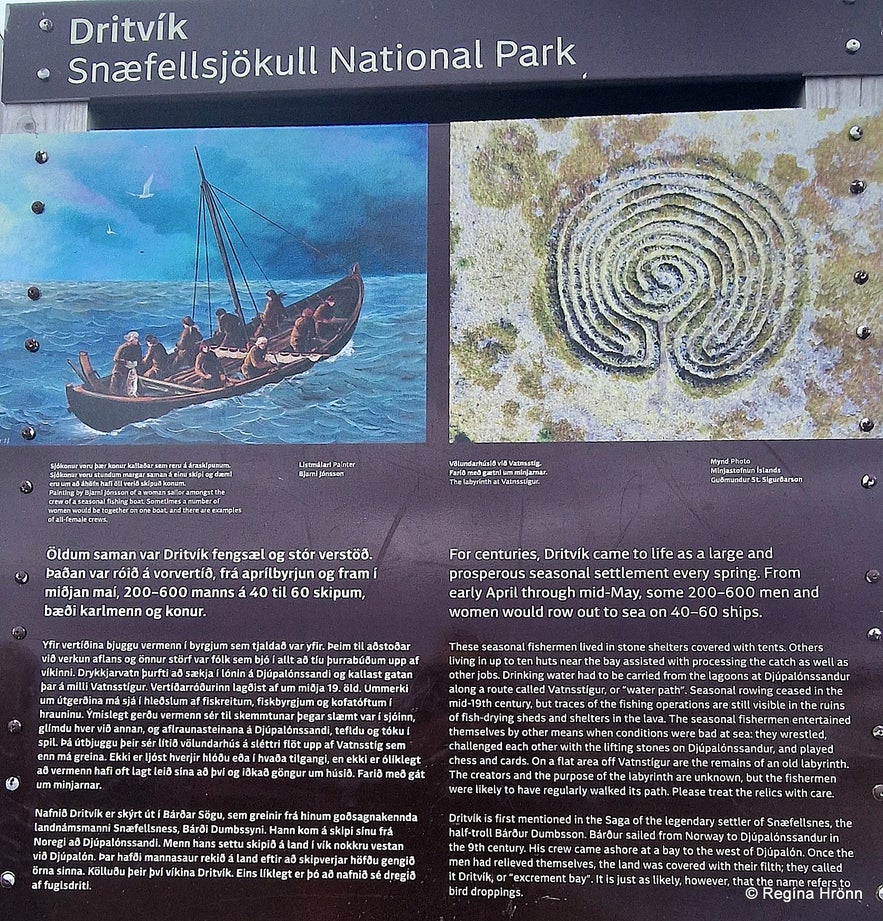 The information sign about Dritvík cove by the parking lot
The information sign about Dritvík cove by the parking lot
The trail on Suðurbarði cape is called Vatnsstígur or the Water trail, as there was no fresh water to be had in Dritvík and water had to be fetched to Djúpalónssandur beach.
The Dritvíkurlón lagoon is mixed with seawater, so it is undrinkable.
Here I was alone in the cove with my husband, thinking about the vibrant past of this deserted cove.
It was almost too quiet, and I felt very alone all of a sudden, thinking about all these men and women now gone from this earth, and how much my country has changed through the centuries.
Dritvík cove on the Snæfellsnes peninsula
When you visit Dritvík, you will notice the pitch black lava formations, which take on all kinds of forms; there is a Tröllakirkja - Troll church, Bárðarskip - the Ship of Bárður, and Bárðartrúss - the Baggage of Bárður.
Remember Bárður Snæfellsás, the half-troll-half-man, who is the Protector of Snæfellsnes peninsula? You can read his story in one of our Sagas - the Saga of Bárður Snæfellsás.
See also my travel blog about Bárður:
Bárður Snæfellsás - the Mythical Protector of the Snæfellsnes Peninsula in West Iceland
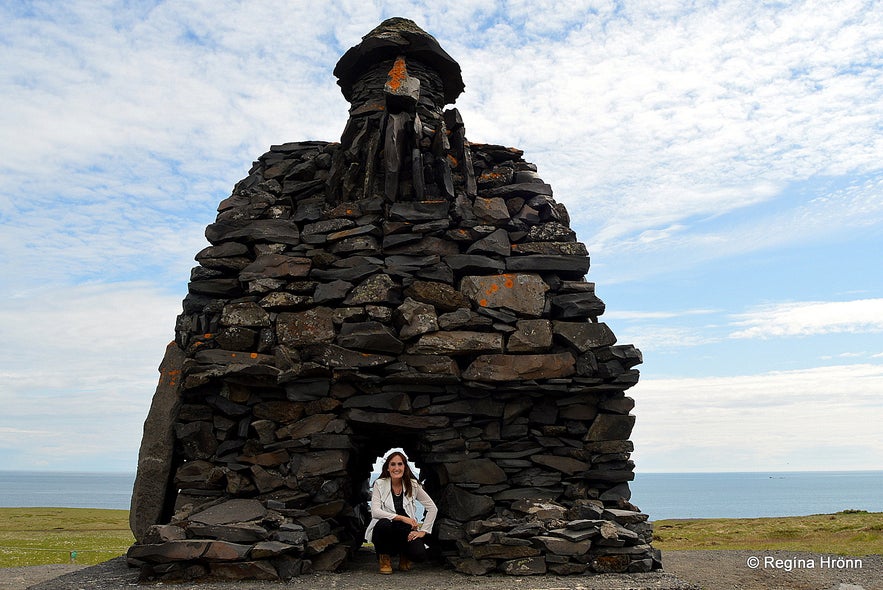
With Bárður at Arnarstapi
Bárður, who was Dumbsson, sailed from Norway with his men in the 9th century and came ashore in Djúpalón and Dritvík cove. He then built his farm at Laugarbrekka further east on the Snæfellsnes peninsula.
Bárður was the one who gave a name to the Snæfellsnes peninsula when he saw the snow and ice on the Snæfellsjökull glacier, which towers over this part of the peninsula.
He called it the Snjófellsnes peninsula. Both the words "snær" and "snjór" mean snow in Icelandic. It was later changed to Snæfellsnes.
Dritvík cove on the Snæfellsnes peninsula
Right in front of us in the photo above, you will see Bárðarskip - the Ship of Bárður in the sea, and to the right of it on the beach is Bárðartrúss or the Baggage of Bárður, referring to the time when Bárður came ashore on Dritvík cove.
Then you will see Víkurklettur rock farthest to the left, inside it is the aquamarine Pollurinn in Maríuhöfn.

Dritvík cove
In this part of the Snæfellsnes, you will find several locations bearing Bárður's name. Close to Laugarbrekka, where Bárður lived, you will discover Bárðarlaug or the Pool of Bárður, where Bárður bathed.
I have written about these locations in other travel blogs about Snæfellsnes:
The Historical Laugarbrekka on the Snæfellsnes Peninsula in West Iceland
In the Saga of Bárður, it is written that the settler Bárður and his men worshipped their heathen gods for luck when they came ashore at Djúpalón, but the Troll Church is in Dritvík, so I hope this is the one in question.

In my photo above, you will see Tröllakirkja - the Troll Church in Dritvík. It is the one stretching into the sea.
There is yet another folklore in Þjóðsögur Jóns Árnasonar - the Compilation of Folklore of Jón Árnason, which I am going to tell you. It explains to us why a certain cave west of Dritvík got the name Draugahellir, or the Ghost Cave:
"There is a cave west of Dritvík in a location called Suðurbarði and Vesturbarði. The story goes that some men were in the vicinity of the cave (aboard a ship - RHR) and heard some noise coming from the cave, which sounded like verbosity, but the story goes that one or two of these men on the ship were from Helgafell (the same strong and hardy fishermen as in the folklore above - RHR).
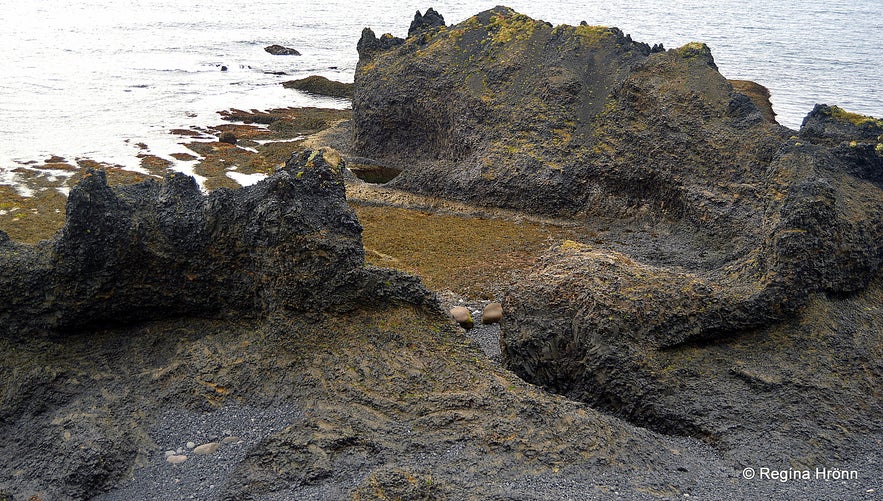
Dritvík cove
One of them was on good terms with the farmer's daughter at Hólahólar, called Narfi (others call him Jón). When they were in the vicinity of the cave, they heard a strong man's voice saying a rhyme:
"Leiðist mér að liggja hér í ljótum helli;
betra er heima á Helgafelli
að hafa þar dans og glímuskelli"
Another man answered with rhyme and they heard him very clearly:
"Fer ég djúpt í fiskageim
fjarri hringasólum;
þó ég sé dofinn dreg ég mig heim
til dóttur Narfa í Hólum".
The entrance to the cave is from above, and it is said that some of the corpses drift from the sea into the cave when the surf is high, and it has since been called Draugahellir or the Ghost Cave."
(Roughly translated into English from Þjóðsögur Jóns Árnasonar - the Compilation of Folklore of Jón Árnason).
A sea-monster-shaped rock in Dritvík
Now, this was a bit difficult to translate, but I hope you get the gist. The rhyme is in Icelandic, but it roughly says that the ghost in the cave is tired of being inside an ugly cave and would be better off at home at Helgafell, where it could dance and wrestle.
The other ghost is talking about him being deep in the realm of the fish, and even though he was feeling numb, he dragged himself home to the daughter of Narfi at Hólar. This is the story that explains why this place is said to be haunted.
On the beach, I found a monster-like lava formation that looked like one of the sea monsters seen around Iceland, mainly in the Westfjords of Iceland.
"Somewhere", hidden away between Dritvík and Djúpalónssandur, lies an old labyrinth.
We don't know exactly how old it is, but it is believed that the seasonal fishermen built it for fun while on shore. It might be older, though.
It is not easy to find. I have visited it and found my way through it, but as it is old and fragile, I will only add a video of me trying it out here and not give directions on where to find it, as too much traffic might ruin it.
Don't you agree with me on this? I know that nowadays everything can be easily found, but let's leave this one be.
To visit this area, you can rent a car in Reykjavík and explore the whole peninsula in a day or two. I almost always visit Snæfellsnes in my own car, but there are several guided tours to Snæfellsnes if you want to be guided around Snæfellsnes.
I have joined two of the Snæfellsnes tours and written travel blogs about the tours:
Snæfellsnes National Park Day tour with Nicetravel and the
Snæfellsnes Minibus expedition with Tröll Expedition
Also check out the myriad of guided tours of Snæfellsnes: the best Snæfellsnes tours.
I have written many more travel blogs about the Snæfellsnes peninsula, as there is just so much history and places of interest everywhere you look.

Below you will find links to my travel guide of Snæfellsnes in 5 parts, in chronological order, with many side blogs:
The Magical Snæfellsnes peninsula - part I
The Magical Snæfellsnes peninsula - part II
The Magical Snæfellsnes peninsula - part III
The Magical Snæfellsnes peninsula - part IV
The Magical Snæfellsnes peninsula - part
This travel blog is a side blog to my travel blog, The Magical Snæfellsnes Peninsula - Part II.
Have a lovely time at Djúpalónssandur and please stay safe on the beach :)

